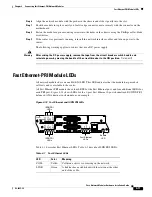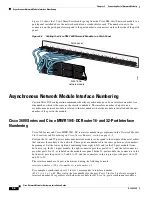
C H A P T E R
5-1
Cisco Network Modules Hardware Installation Guide
OL-2485-20
5
Connecting Serial Network Modules
This chapter describes how to connect serial network modules for Cisco modular routers and contains
the following sections:
•
About Serial Connections, page 5-1
•
Connecting Asynchronous Network Modules to Asynchronous Devices, page 5-4
•
Asynchronous Network Module Interface Numbering, page 5-6
•
4-Port Serial Network Module, page 5-9
•
16- and 32-Port Asynchronous Serial Network Modules, page 5-11
•
4-, 8-, and 16-Port Asynchronous/Synchronous Serial Network Modules, page 5-12
Tip
To determine whether your router supports a specific network module, see
Table 1-6 on page 1-16
.
About Serial Connections
Serial connections can be provided by either WAN interface cards or network modules. For more
information about WAN interface cards, see the
Cisco Interface Cards Hardware Installation Guide
. To
obtain this publication, see the
“Obtaining Documentation” section on page viii
.
Before you connect a device to a serial port, you need to know the following:
•
Type of device—data terminal equipment (DTE) or data communications equipment (DCE)—you
are connecting to
•
Type of connector, male or female, needed to connect to the device
•
Signaling standard required by the device
About DTE and DCE Devices
A device that communicates over a synchronous serial interface is either a DTE or a DCE device. A DCE
device provides a clock signal between the device and the router. A DTE device does not provide a clock
signal. DTE devices usually connect to DCE devices. The documentation that accompanied the device
should tell you whether it is DTE or DCE. (Some devices have a jumper to select DTE or DCE mode.)
If you cannot find this information in your documentation, see
Table 5-1
to help you determine the
proper device type.
















































